Laboratories and companies that utilize environment controlled rooms must do all they can to maintain the highest levels of safety and insure that all precautions are taken so that nothing will contaminate their environment and the valuable assets contained within them.
This is as important an undertaking and has a great bearing on the actual experiment or research being conducted. There are standards in place that involve wearing safety gear, making extensive documentation, labeling everything using laboratory label tape, and being properly trained in using highly specialized machines and equipment.
This is why laboratories are designed a certain way with many of them looking nearly exactly the same and also why they each set up protocols that must be strictly adhered to by everyone entering the laboratory. Here are the things that all laboratories use to be the most effective:
Correct Lab Equipment
Utilizing the correct lab equipment is of the utmost importance to ensure that the things going on in the lab are up to the standards required. For example, if you are studying microorganisms, the importance of studying them in their own environment is critical. The right tool for this endeavor is an Anaerobic Glove Box for Labs that focus on this area of research.
Anaerobic glove boxes were developed to study the growth of anaerobic microorganisms: those that thrive without oxygen. These completely sealed boxes allows the scientist to utilize gloves – disposable and otherwise (from the likes of companies similar to unigloves) that go into a completely sealed chamber manipulate their experiments. Anaerobic glove chambers have been instrumental in breakthroughs in the fields of medicine, biofuels, bioremediation, and drug discovery to treat pathogenic organisms. Using this tool when it is needed plays a big role in getting the correct results.
Additionally, laboratories utilize the proper biosafety cabinet (BSC). Because there is the risk of contamination, every time the door is opened, its incubator design must be advanced with an ability to offer HEPA filtration that establishes ISO 5 cleanroom conditions within five minutes of the door opening. Some also have CO2 sensors and controls for humidity. Similarly, many labs buy distilled water and use it to clean the tools as demineralized water can absorb impurities from surfaces it comes in contact with, making the tool free of contamination. The use of these advanced systems go a long way toward protecting test results in the lab.
Correct Lab Design
A lab must be designed so that equipment is placed strategically relative to experiments being conducted. In terms of the area of the lab used for cell culture, it must be given special attention to ensure that it is out of the range of all potential contaminants. This means far away from sinks that may splash water and not in the direct line of any HVAC units which can spew out contaminants unbeknownst to anyone in the lab.
Precise Culturing Processes
In a laboratory, following correct procedures regarding culturing is very important, and everyone working in the lab should be trained to do this. Good Pipetting Practice (GPP) is supports sample integrity and accuracy. Proper procedures should include working with one cell at a time in the lab as to avoid inadvertent switching of cell lines, which will result in flawed and unreliable data. There also need to be adhered to protocols around monthly testing for mycoplasma.
- Best learning toys for children as they age - July 19, 2023
- Luxury yacht charter vs. standard yacht charter: Which is right for you? - February 7, 2023
- Comfortable Shoes for Being on Your Feet All Day - January 10, 2023

Like It? Share It!